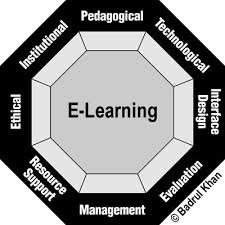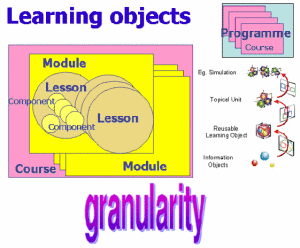Pedagogical Elements & Reusability Standards
OVERVIEW
Pedagogical (the science of education) elements are an attempt to define structures or units of educational material. For example, this could be a lesson, an assignment, a multiple choice question, a quiz, a discussion group or a case study. These units should be format independent, so although it may be in any of the following methods, pedagogical structures would not include a textbook, a web page, a video conference or podcast.
When beginning to create eLearning content, the pedagogical approaches need to be evaluated. Simple pedagogical approaches make it easy to create content, but lack of flexibility, richness and downstream functionality come in the way. On the other hand, complex pedagogical approaches can be difficult to set up and slow to develop, though they have the potential to provide more engaging learning experiences for students. Somewhere between these extremes is an ideal pedagogy that allows a particular educator to effectively create educational materials while simultaneously providing the most engaging educational experiences for students. 
It is possible to use various pedagogical approaches for eLearning which include:
SOCIAL-CONSTRUCTIVISTS – this pedagogy is particularly well afforded by the use of discussion forums, blogs, wiki and on-line collaborative activities. It is a collaborative approach that opens educational content creation to a wider group including the students themselves. The One Laptop per Child Foundation attempted to use a constructivist approach in its project.
LAURILLARD’S CONVERSATIONAL MODEL– is also particularly relevant to eLearning, and Gilly Salmons’ Five-Stage Model is a pedagogical approach to the use of discussion boards.
COGNITIVE PERSPECTIVE – focuses on the cognitive processes involved in learning as well as how the brain works.
EMOTIONAL PERSPECTIVE – focuses on the emotional aspects of learning, like motivation, engagement, fun, etc.
BEHAVIORAL PERSPECTIVE – focuses on the skills and behavioral outcomes of the learning process. Role-playing and application to on-the-job settings are a characteristic of the Behavioral Perspective.
CONTEXTUAL PERSPECTIVE – focuses on the environmental and social aspects such as interaction with other people, collaborative discovery and the importance of peer support as well as pressure which can stimulate learning.
MODE NEUTRAL – Convergence or promotion of ‘transmodal’ learning where online and classroom learners can coexist within one learning environment thus encouraging interconnectivity and the harnessing of collective intelligence
REUSABILITY, STANDARDS, and LEARNING OBJECTIVES
Much effort has been put into the technical reuse of electronically based teaching materials and in particular creating or re-using Learning Objects. These are self-contained units that are properly tagged with keywords, or other metadata, and often stored in an Extensible Markup Language (XML) file format. Creating a course requires putting together a sequence of learning objects. There are proprietary and open, non-commercial and commercial, peer-reviewed repositories of learning objects such as the Merlot repository.
A common standard format for e-learning content is SCORM. Other specifications allow for the transporting of “Learning Objects” (Schools Framework) or categorizing Learning Objects Metadata (LOM).
These standards themselves are early in the maturity process with the oldest being 8 years old. They are also relatively vertical specific: SIF is primarily pK-12, LOM is primarily Corp, Military and Higher Ed, and SCORM is primarily Military and Corp with some Higher Ed., the Post-Secondary Education Standards Council (PESC), is also making headway in developing standards and learning objects for the Higher Ed space, while SIF is beginning to seriously turn towards Instructional and Curriculum learning objects.
In the US pK12 space there are a host of content standards that are critical as well- the NCES data standards are a prime example. Each state government’s content standards and achievement benchmarks are critical metadata for linking e-learning objects in that space.
An excellent example of e-learning that relates to knowledge management and reusability is Navy E-Learning, which is available to Active Duty, Retired, or Disable Military members. This on-line tool provides certificate courses to enrich the user in various subjects related to military training and civilian skill sets. The e-learning system not only provides learning objectives, but also evaluates the progress of the student and credit can be earned toward higher learning institutions. The Internet allows for learning to be directed at one’s current objectives. This reuse is an excellent example of knowledge retention and the cyclical process of knowledge transfer and use of data and records. Wikipedia

Recent Comments